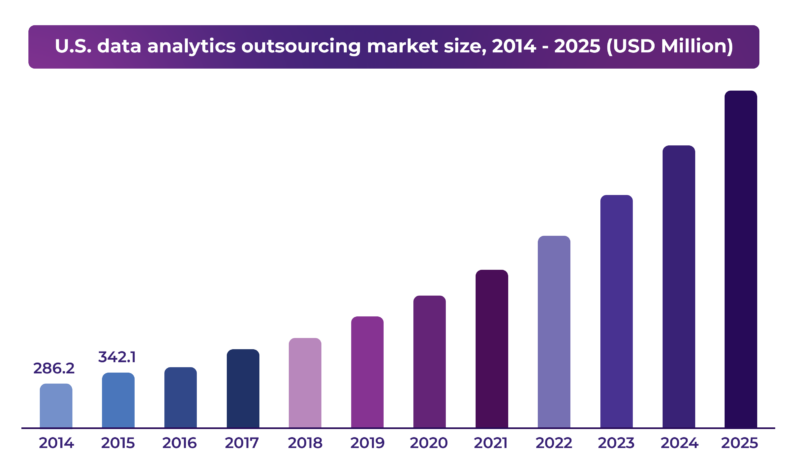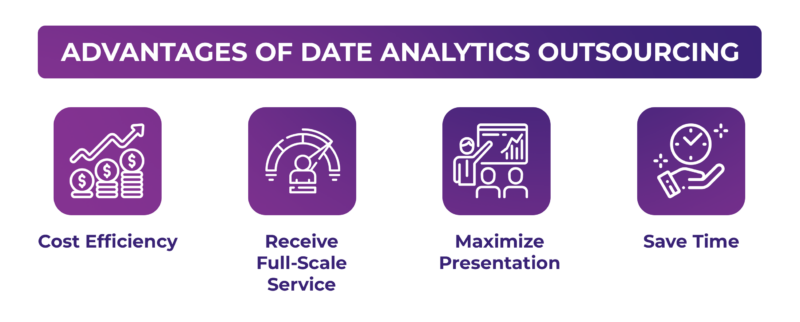Businesses today collect a significant amount of data that can be used for data-driven decision-making. As data volumes increase and analytical processes get more complex, companies seek innovative ways to ensure accurate, timely, and actionable insights. The strategic outsourcing of data analytics is one approach that is gaining momentum.
Data analytics outsourcing is a practice of delegating the difficult task of data collection, processing, and analysis to external professionals who specialize in deciphering complex data sets and using cutting-edge technologies. It offers numerous advantages, from cost efficiency to increased focus on core business functions. This article will navigate the complexities of outsourcing analytics, providing an overview of the important factors to consider, best practices, and potential challenges.

Benefits of Outsourcing Data Analytics
Cost Savings
By outsourcing data analytics functions, businesses can save the costs of recruiting, hiring, and training a team of data analysts and data scientists. Instead, they can tap into a pool of experts well-versed in various analytical tools and approaches. This not only saves time and money but also ensures the quality of the analyses conducted.
Outsourcing reduces the need for ongoing investments in infrastructure, software licenses, and hardware updates required to operate an in-house data analytics department. This can help allocate resources more efficiently and redirect funds to strategic initiatives like research and development.
Improved Customer Satisfaction
By leveraging external data analytics expertise and advanced analytical tools, businesses can obtain deeper insights into customer behaviors, preferences, and demands. These insights help businesses tailor their products and service offerings to align closely with customer expectations, enhancing customer satisfaction and loyalty.

Access to a Larger Pool of Talent
Outsourcing data analytics helps you benefit from diverse skills and expertise that may not be easily available in your local data analytics outsourcing market. It enables you to choose from a wide range of professionals with various specializations to meet your data analytics needs.
Improved efficiency
Companies may improve their data analysis processes, shorten project timelines, and gain faster insights through the expertise of external experts. Skilled analytics teams have a wealth of experience that enables them to manage large data sets, use advanced algorithms, and uncover valuable patterns and trends. This increased efficiency speeds up decision-making and optimizes resource use, allowing internal teams to focus on key business operations.
Steps for Outsourcing Data Analytics Effectively
Define Your Customer Service Needs
Start by thoroughly evaluating your business goals, current data capabilities, and insights you seek to achieve. The types of data to be analyzed, the desired outcomes, and the expected timeline should all be included in the project’s scope. This clarity helps in choosing the right outsourcing partner and guarantees that your expectations and the services received are aligned.
Research Outsourcing Options
Start by choosing data analytics service providers with track records and solid industry reputations. Evaluate their expertise, technological capabilities, and the services they offer to ensure alignment with your specific requirements.
Researching your outsourcing options can help you avoid potential risks, such as misaligned expectations, communication breakdowns, and substandard results. Early warning signs enable you to make informed decisions.
We recommend checking out The New Workforce as you search for your data analytics partner. The New Workforce is an outsourcing company that offers a range of services for affordable packages. They also provide outsourcing options for sales, marketing, IT, and customer service.
Develop a Clear Communication Plan
A clear communication plan minimizes the risk of misunderstandings and misaligned expectations. Start by identifying the key stakeholders from your organization and the external partner. Outline the goals of the communication plan, whether for project updates, discussing challenges, addressing changes, or sharing insights. Once defined, establish the communication channels and the frequency of communication.
Identify who will provide updates, who will receive them, and how the information will move between project levels. Define the escalation process, responsible personnel, and the steps for handling critical matters.
Communication needs can change over time, so it is important to assess the communication strategy regularly and make adjustments as necessary. Gather feedback from both sides on how communication can be improved to better support the project.
Implement and Monitor the Outsourcing Process
Meet with the key stakeholders from your internal team and the outsourced partner to review the project scope, expectations, and roles to ensure everyone is on the same page. Maintain a record of all communications, decisions, and agreements between your organization and the external service provider. This will help prevent misunderstandings and serves as a reference for future discussions.
Regularly evaluate the performance of the data analytics outsourcing partner based on the defined KPIs and project goals. This monitoring can help decide whether to continue the partnership and pursue new initiatives.
Factors to Consider when Outsourcing Data Analytics
Quality of Services
It is critical to ensure the delivery of high-quality analytics to draw correct insights and make informed business decisions. Effective data management, accuracy, and reliability of the insights generated are essential to the effectiveness of predictive analytics. The outsourced partner’s predictive modeling expertise and algorithmic capabilities must be considered.
Companies should evaluate the outsourcing provider’s competence, track record, and technological capabilities in managing complex data processing tasks. A well-established reputation for data accuracy, comprehensive methodologies, and adherence to industry best practices illustrates the outsourced partner’s dedication to quality.
Availability and accessibility
The responsiveness and readiness of the external partner to engage and respond to inquiries, issues, and updates on time are critical to having a smooth and efficient engagement.
Accessibility refers to the ease with which data, insights, and progress can be accessed. A secure data-sharing mechanism, user-friendly platform, and transparent reporting systems promote a sense of control and transparency in the outsourced process.
Evaluating the outsourced partner’s commitment to availability and accessibility helps build a partnership based on effective communication and a seamless flow of data analytics outcomes.
Cost
While cost savings is often the primary motivating factor for outsourcing, it’s essential to assess its broader financial implications. Companies should consider not only the initial cost of outsourcing but also the long-term cost-effectiveness. This includes weighing the costs of outsourcing against the potential benefits of improved efficiency, access to specialized expertise, and scalability. Companies should choose providers with transparent pricing structures that clearly outlines the services offered and any additional charges.
Cultural Compatibility
The success of collaboration can be strongly impacted by the alignment of cultural values and work ethics between the outsourcing partner and the hiring organization. Communication is easier, there are fewer misunderstandings, and collaboration is more effective with a shared cultural understanding. It also promotes a harmonious working environment, contributing to a positive and productive one.
Tips for a Successful Outsourced Data Analytics
Foster Open and Clear Communication
Clear and open lines of communication between your business and the outsourcing partner are critical for ensuring project alignment, transparency, and success. Start by establishing clear communication channels and protocols, ensuring that team members on both sides are reachable and responsive. Encourage open communication so issues can be addressed promptly and solutions collaboratively developed. Understanding the insights from the outsourced team and offering constructive feedback is important to stay aligned with the business objectives.
Maintain a consistent brand voice
The voice of your brand is its unique personality, and it should be consistent throughout all data-driven communications and insights. Start by explaining to your outsourced partner your brand’s core values and the tone and messaging standards you follow. This will help them align their analytical findings and recommendations with your brand’s identity, ensuring that each piece of data-driven content resonates with your customers. Regularly share customer insights, recent marketing campaigns, and brand-specific changes with the external team so they may adjust their analytical approach accordingly.
Use Technology to Your Advantage
Collaborate with your outsourcing partner to identify the best technology stack for your project’s requirements. Implement cloud-based solutions that enable seamless data sharing and real-time collaboration, allowing both teams to operate more efficiently. Automation may significantly improve productivity by handling repetitive tasks, enabling your internal team to focus on value-added activities. Use advanced analytics approaches such as machine learning and artificial intelligence to glean deeper insights from complex data.
Continuously evaluate and improve the outsourcing process
Consistently reviewing and improving the outsourcing process is an essential approach to attain successful analytics outsourcing. Regularly evaluate the project’s progress against predetermined benchmarks and objectives to ensure that the partnership remains aligned with the changing business demands. Promote open communication and collaboration between your internal team and the outsourced partner to identify areas that need improvement and to gain insights into what is working effectively. To maximize the results of your data analytics initiatives, flexibility is essential. Be ready to adjust to evolving conditions and technologies.
Potential Challenges of Outsourcing Data Analytics and How to Overcome Them
Language Barriers
Language barriers can impede communication, causing project timelines and decision-making delays. This can impact the overall efficiency of the data analytics project. It can also be challenging to ensure the accuracy and quality of data analysis and reporting if there are language barriers. Misinterpretation of instructions or data might lead to incorrect insights. To address language barriers,
- Document project details, requirements, and expectations in writing to reduce the possibility of misinterpretation. Create a glossary of technical terms to ensure common understanding.
- Outline quality standards and guidelines for data analysis, visualization, and reporting in detail.
- Establish a robust feedback process for reviewing work, providing feedback, and revising before finalizing deliverables.
Time Differences
Significant time differences can cause communication delays between your internal and the outsourced team. This can affect project timelines as tasks requiring inputs or approval from both sides may experience delays. To manage time differences,
- Implement overlapping working hours where both teams are available or communication and meetings. Schedule regular meetings during these hours to discuss important concerns.
- To ensure both parties are aligned with the project plan, clearly specify milestones and deadlines while considering time zone differences. Include buffer time in the project timeline to account for potential delays due to time differences.
- Rotate the timings of discussions and meetings to ensure that no team is consistently disadvantaged by early or late hours.
While time differences might pose challenges when outsourcing data analytics, proactive planning and effective communication can help mitigate these issues and foster successful collaboration across global teams.
Maintaining Control Over the Customer Experience
Outsourcing partners may not completely grasp your organization’s unique customer experience goals, resulting in a gap between your vision and their actions. It can also lead to erroneous findings that can influence customer experience. Furthermore, maintaining accountability for the customer experience might be difficult when tasks are distributed between your internal teams and the outsourcing partner. To effectively manage control over customer experience,
- To establish alignment from the start of the project, provide detailed guidelines, objectives, expectations, and desired outcomes related to the customer experience. Establish regular check-ins and progress reports to check whether the outsourcing team’s efforts are aligned with the customer experience objectives.
- Define quality metrics for the external team, and conduct regular quality reviews. Implement a thorough review process with feedback loops to ensure accurate and reliable data analysis.
- To eliminate confusion, clearly define roles, responsibilities, and ownership of various areas of the customer experience. Use KPIs to track the impact of data analytics on customer experience.
A well-structured and robust data analytics process streamlines outsourcing operations and enables businesses to realize the true value of their data. Adopting a strategic approach of outsourcing data analytics provides numerous advantages that can drive a company’s growth and competitive advantage.
By partnering with specialized service providers, businesses can leverage advanced technology and diverse data analytics skills to extract vital insights from their data, enabling informed decision-making and improved operational efficiency.
A successful outsourcing project, however, requires careful consideration of factors such as quality of services, availability and accessibility, cost, and cultural compatibility. Organizations may unlock the full potential of data analytics outsourcing by creating a healthy balance between internal talents and external support, positioning themselves to thrive in an increasingly complex business environment.



Leave A Comment
You must be logged in to post a comment.